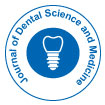当社グループは 3,000 以上の世界的なカンファレンスシリーズ 米国、ヨーロッパ、世界中で毎年イベントが開催されます。 1,000 のより科学的な学会からの支援を受けたアジア および 700 以上の オープン アクセスを発行ジャーナルには 50,000 人以上の著名人が掲載されており、科学者が編集委員として名高い
。オープンアクセスジャーナルはより多くの読者と引用を獲得
700 ジャーナル と 15,000,000 人の読者 各ジャーナルは 25,000 人以上の読者を獲得
インデックス付き
- レフシーク
- ハムダード大学
- エブスコ アリゾナ州
- ICMJE
役立つリンク
オープンアクセスジャーナル
このページをシェアする
抽象的な
Regenerative pulpotomy: A novel strategy for local regeneration of dental pulp
Mobarak A
The major goal of all restorative procedures is to maintain the viability of the dental pulp whenever possible. Over the last few decades, minimally invasive endodontic techniques have been introduced and have received wider acceptance over conventional treatments. These techniques could serve as viable, less invasive, potential treatment options for the management of teeth with inflamed pulps compared to the conventional approach of root canal treatment, preventing unnecessary dental extractions.
Minimally invasive techniques are based on the ability of the remaining radicular pulp to recover following the removal of the infected coronal pulp tissue and placement of a suitable medicament.
Dental pulp stem cells were isolated from irreversibly inflamed pulp tissue, maintaining the potential of cell proliferation and differentiation, Serving as a source of endogenous multipotent cells needed for the regeneration of the pulp-dentin complex. This has changed the general understanding of a clinical diagnosis of irreversible pulpitis and its management, particularly in the era of improved understanding of the healing process and regeneration of the pulp-dentin complex, cases traditionally deemed irreversible may in fact still be savable, thereby shifting the balance of what was irreversible towards reversible, when the correct treatment is applied
Despite these great improvements, various biomaterials have mild to moderate cytotoxic effects when they are placed in direct contact with the pulp tissue, also these techniques itself never lead to the regeneration of pulp or dentin that was lost in the coronal portion.
So a novel strategy for the local regeneration of dentin-pulp complex in the pulp chamber is introduced as “Regenerative Pulpotomy” based on the induction of the outgrowth of pulp cells, capillaries, and neurons from the residual root pulp using a biodegradable autologous scaffold.

 English
English  Spanish
Spanish  Chinese
Chinese  Russian
Russian  German
German  French
French  Portuguese
Portuguese  Hindi
Hindi